When I first discovered the magic that is weaving, all my senses jumped alive at once. It happened in the late 1980s when I sauntered into the Mendocino Art Center to see what was there during a visit from my Sacramento home to that area near the CA coast. A textile apprenticeship program was offered then and while looking around the studio classroom, I was joyfully saturated with color, pattern and texture by the yarns and variety of items that could be woven by hand. I was not typically interested in things mechanical, but the looms, shuttles, forks and other mysterious tools, mostly of natural wood, drew me in. I had to learn more.
Fortunately, there is a yarn and fiber crafts shop in Sacramento where I was able to take a basic weaving class and make my first handwoven item, a scarf (which I still love and wear) on a rigid heddle loom. Since then, I’ve acquired a few looms of my own and have continued to explore techniques of this wonderful craft. I enjoy weaving a variety of textiles from wearables to wall art, tapestry being my favorite.
Sometime during the first half of the 1990s, I came across the book, Tapestry Weaving: A Comprehensive Study Guide, by Nancy Harvey, while browsing the shelves at the yarn shop. Its clear diagrams and lovely tapestry photos gave me the idea I might like to try this seemingly more direct and intimate way of weaving. I’d already experienced the joy of creating glorious cloth by throwing a shuttle. When I imagined the feeling of fingering warp yarns while being able to form designs wherever I wanted, this technique seemed very appealing. So I bought the book, made a nail frame loom according to the instructions given and picked up a few lovely wooden tapestry forks and battens while at CNCH. I then proceeded to learn basic tapestry techniques while, over time, I wove the samples in Nancy’s book.
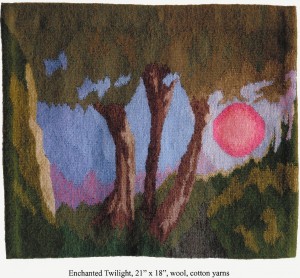
Enchanted Twilight
Once I started to get the hang of it, tapestry was as satisfying as I thought it might be. Several years later, I actually had the good fortune of learning further from Nancy in person as part of our mutual membership in Sacramento Weavers & Spinners Guild. Not only did she share her knowledge while presenting at some meetings, but she also taught tapestry techniques to some of us in a small study group she’d offered to lead. As a result of what I learned from Nancy during this time, I wove the tapestry titled Enchanted Twilight on my 60” Leclerc Tissart vertical tapestry loom.
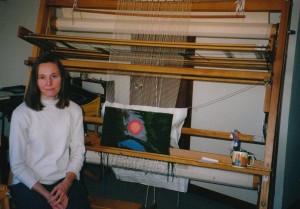
Therese with Enchanted Twilight on Leclercloom
I bought this loom in 1995 at a very reasonable price from a guild friend who had herself purchased it second hand (at least) some years earlier. It has many features that help make tapestry weaving go smoothly. It is sturdy and wide enough for me to weave pieces that can be of some size. Warp for tapestry should have very high tension and be evenly spaced to enable the weft to pack well and fully cover it. The reed in the loom’s pull down beater uniformly separates the ends and can be assisted by a raddle secured to the loom’s frame across the top. In tapestries where design sections lend themselves to it, as with those having geometric shapes (see photos), in each row I may weave the individual areas across the entire width instead of building up design areas separately. In this case, in addition to using a fork to pack the weft, I am also able to use the beater for further, even compression.
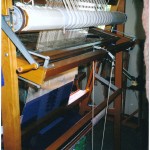
Back view of Lattice on Leclerc
Warp can be of any length with this loom as it has rolling warp and cloth beams. These have aprons attached and metal end sticks for securing the warp. Tension is controlled by metal ratchets and pawl, which allow the warp to be tightened to a high degree. Foot pedals are connected with cotton cord to the harness bars above the beater area. When pressed, these activate the harnesses holding metal heddles, which move back and forth in horizontal motion and cause the sheds to open easily. And with this upright style loom, I can clearly see how the work is progressing from both front and back.
I have used other looms to weave tapestry. Around the turn of the century, I took a workshop given by tapestry artist James Koehler at his studio in Santa Fe, NM. There I increased my understanding of color and design principles as well as tapestry technique while weaving samples on a Macomber floor loom. Back home, I’ve since woven a few small tapestries on my Schacht Mighty Wolf jack style floor loom, which can provide tension adequate for narrow pieces. And with my Heritage frame loom and preferably outdoors, I weave in Navajo style using techniques learned from Marilyn Greaves and Mel Silva of the Sacramento Weavers & Spinners Guild.
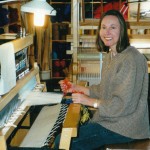
At Macomber Loom in studio of James Koehler
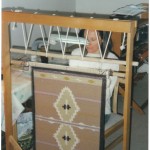
Therese completing Navajo weaving, back view
For me, tapestry weaving gives the sense of being present in the moment where I am free to make design choices and relish its sensory input. The under one, over one (warp end) basic nature of tapestry is weaving in its essence and I hope my work is a reflection of the creative power in such simplicity. Use of a sturdy loom having features such as those described above support my efforts and promote creation of a successful piece.
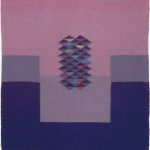
Lattice
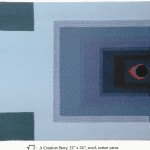
Square Root of Two: A Creation Story
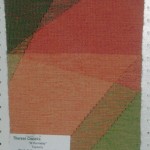
In Harmony (or Harmonic Gladioli)